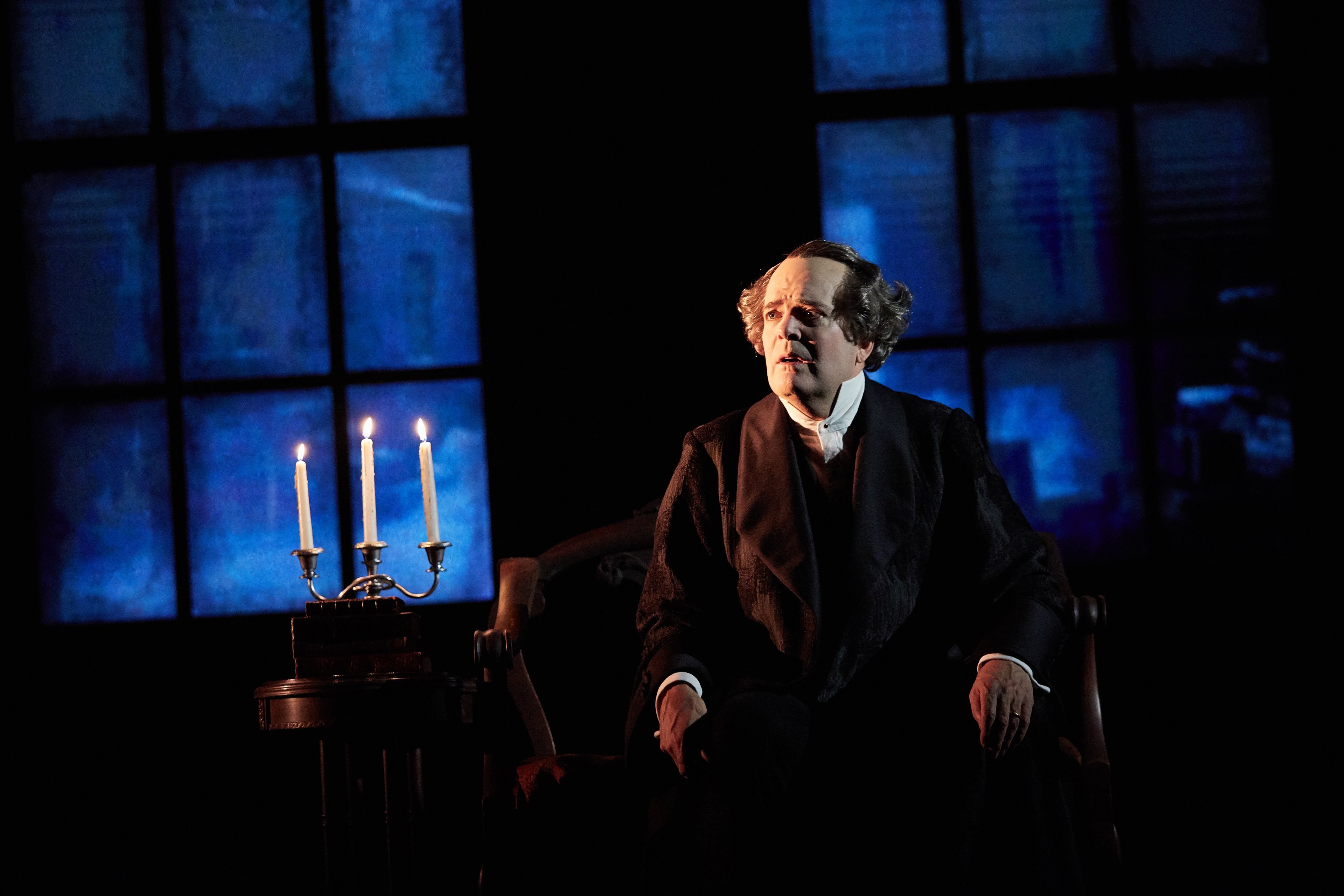An adaptation of Charles Dickens’ “A Christmas Carol” plays at Geffen Playhouse in west Los Angeles through Dec. 16 — but this isn’t your ordinary “A Christmas Carol.” Geffen’s “A Christmas Carol” transforms the iconic story into a piece frozen in time, performed as a solo show by Tony Award winner Jefferson Mays. In 90 minutes, Mays and director Michael Arden bring the story to life in a whole new light, allowing the happy end to spring forth from Scrooge’s three-ghost destruction in the first part of the play.
Mays plays every character and sometimes functions as a narrator as well, jumping seamlessly from part to part with simply a change in posture and a vocal alteration. Wearing a simple black trench coat (with costume design by Dane Laffre), Mays is most identifiable as the main character of Scrooge, but he even becomes Tiny Tim and other famous characters. Mays’ performance is a tribute to the power of theater and suspension of disbelief — we never see Mays really transform visually onstage, but it’s so easy to get sucked in and not only hear but also see each character in Mays. Every change in facial expression, every quick move contributes to the youth or the age of each character that emanates from Mays.
Yet Geffen Playhouse’s production doesn’t stop at a magical performance, and perhaps the most astounding part of the show is the technical elements brought to the table. With scenic design also by Laffrey, the Geffen stage is transformed impossibly smoothly as beds literally appear and disappear before our eyes and set pieces move on a rotating platform and turning each setting into the next. Laffrey’s scenic design strongly complements the superb lighting design by Ben Stanton, a highlight being a slotted lighting pattern in one scene and the glowing lights that helped Mays turn from one character into another by simply turning into a different pool of light.
This performance includes a content warning for horror-associated imagery, and I can attest to this. Through both lighting and sound design by Joshua D. Reid, “A Christmas Carol” took on a shockingly abrasive horror vibe from the start, beginning with a massive crack of sound and descending into darkness. With theater, it’s almost impossible to scare the audience without jump scares, and while “A Christmas Carol” does indulge in its own set of loud sounds and lights, the show more so pushes towards the sublime with its smoke effects and heart-wrenchingly beautiful visuals.
Lucy Mackinnon’s projection design is also particularly notable, including an elaborate projection sequence involving a dinner party and a moving shadow on the stage’s back wall. The projection design brought life to the stage and to Mays’ already excellent performance, but with a solo performer, projections take on their own new life as almost a character onstage. It’s one thing to notice the immersive projection design, but it’s another to not even realize how much was part of projection and how much were there visual and special effects. With projection design so fully integrated into the set, it was nearly impossible to really pinpoint where the projections started and where the set ended.
Last but not least of all, Michael Arden directs Mays in “A Christmas Carol,” and it’s masterful. Arden has Mays interact with the space in so many different ways, evoking both fear and glee, and Arden’s artistic cohesiveness is palpable. As one of the three adaptors of this version (the others being Mays and Susan Lyons), Arden has the creative freedom to allow the script to inform the production and vice versa (especially as the world premiere). Certain moments are so perfectly timed — door knocks and doors swinging, echoes in the room and lights that seemingly appear out of nowhere — that it’s as if the script was written for the production. And so, in many ways, it was, but certainly not to the level of precision that Arden simply brings out in Mays and the designers.
Geffen Playhouse’s production value of “A Christmas Carol” is clearly through the roof, and the spectacle is part of the appeal, especially during the holidays. This is one of the most visually and artistically astounding theatrical productions I’ve seen, derived from a classic story that’s been done many times before. Yet this production doesn’t lose its charm with its bright lights and beautiful sets — it only adds to Mays’ impressive 90-minute feat, never stumbling once or breaking from his ovation-deserving narrative tour de force.
Contact Olivia Popp at oliviapopp ‘at’ stanford.edu.
